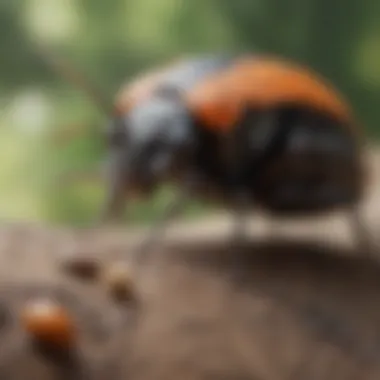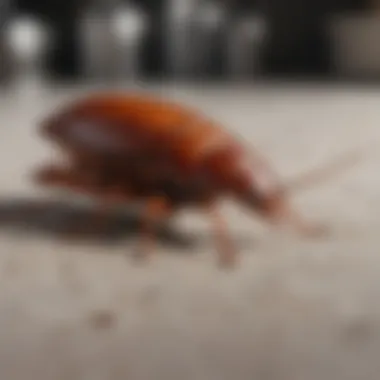Types of Household Bugs: A Comprehensive Guide


Intro
Household bugs often go unnoticed, scrambling in the corners, crevices, and hidden spots of our homes. These critters, from the tiniest ants to the occasional silverfish, weave an intricate web within our daily lives that few consider. Understanding these insects is not just about pest control; it’s about recognizing their role in our environment and ensuring our living spaces remain healthy and safe.
When it comes to household bugs, knowledge is indeed power. It’s vital to peek behind the curtains of our homes and explore who these often ignored inhabitants are. It’s more than just extermination; it’s about learning to coexist or managing the nuisances they present. This article will dive into the nitty-gritty of various household bugs, offering insights into their behavior, habitats, and the impacts they have on our lives.
By breaking down these pests into distinct types, we hope to equip readers—whether they be educators, students, veterinarians, or wildlife biologists—with a solid grasp of what lurks beneath the sofa and in the attic. With effective identification and management strategies, one can foster a living environment that is both comfortable and pest-free.
Let’s embark on this informative journey to unveil the world of household bugs.
Prelims to Household Bugs
Understanding the world of household bugs goes beyond mere curiosity; it's an integral aspect of maintaining a healthy living environment. The very foundation of this article lies in recognizing the diversity of these small creatures that share our space. Bugs can seem insignificant, yet their impact is substantial. Knowing their kinds and behaviors becomes essential in both pest management and overall ecological balance.
Household ecosystems often host a chaotic web of interactions, wherein bugs play pivotal roles. They contribute to nutrient cycling, pollination, and even pest control by preying on harmful insects. Simultaneously, some species can introduce risks to human health and property. As awareness grows, so does the importance of effectively addressing this delicate balance within our homes.
"In the grand scheme of things, bugs in our homes can either be allies or adversaries. Understanding who’s who is essential.”
In this guide, we dive deep into the different types of bugs typically found in homes, dissect their behaviors, and unveil control strategies that allow coexistence with these tiny tenants for a safe living space. Deeming this comprehension crucial is not just about avoidance but also about embracing practices that foster harmonious interactions among the myriad of creatures that inhabit our environments. Let's break down the main elements that shape household bug ecosystems.
Understanding Household Ecosystems
Household bugs create a microcosm that reflects a larger natural world. Each bug species contributes to the local ecosystem in various ways; some recycle nutrients, while others serve as prey or predators. Consider ants, for instance, with their ability to aerate soil and decompose organic matter, playing a key role in keeping environments functional.
Many individuals may not realize the interconnected nature of these ecosystems. Bugs do not operate in isolation; they are linked through food webs, forming alliances and rivalries that influence their behaviors. When a deterrent is introduced, such as pesticides, it not only affects the targeted species but can also ripple throughout the entire ecosystem. This phenomenon underscores the value of thoughtful pest control methods that prioritize ecological harmony.
The Role of Bugs in Human Environments
Bugs fill various roles in human spaces, embodying both positive and negative aspects. On one hand, beneficial insects are known for their tasks, such as pollination, which fuels plant growth. Ladybugs and lacewings are popular examples of natural pest controllers, warding off problematic species like aphids. On the other side, pests such as cockroaches and termites can wreak havoc, inducing damage to property and posing health risks.
Potential health implications necessitate awareness. For instance, cockroaches are not only a nuisance; they carry allergens that may expose individuals to asthma and other respiratory conditions.
Understanding this duality allows individuals to appreciate the complexities of these creatures. By recognizing their contributions, we can foster environments that reduce harmful infestations while preserving the benefits of beneficial species.
By engaging thoughtfully with our domestic bug community, we can promote healthy living spaces—ones that co-exist with nature without compromising human interests.
Common Types of Household Bugs
Understanding the common types of household bugs is essential for anyone looking to keep their living spaces pest-free. These bugs are not just uninvited guests; they can influence our health, comfort, and even our financial well-being through property damage. Learning about these insects allows one to recognize behaviors and habitats that are conducive to their proliferation, and, in turn, helps to devise effective control strategies.
Ants
Behavior and Social Structure
Ants are fascinating creatures that exhibit complex social behaviors. They live in colonies, and their interactions are highly structured. The division of labor in an ant colony is one of their most distinctive traits; worker ants, for instance, gather food, defend the nest, and assist in reproducing the next generation. Understanding their behavior and social structure can help identify the root of an infestation. Ants are generally seen as a popular choice of study in this article because they are among the most common household pests. Their ability to adapt and organize provides insight into not only pest behaviors but also the methods for controlling them.
One unique feature of ant behavior is their trail pheromones, which they use to communicate and guide fellow ants to resources. This is advantageous because if you can dismantle their trails, you can effectively disrupt their foraging.
Types of Ants Found Indoors
When talking about the types of ants, it’s crucial to mention that some species tend to invade houses more than others. While many know of the common black household ant, like the odorous house ant or the carpenter ant, it's vital to highlight that different species exhibit varying behaviors and levels of aggression when threatened. Knowing which type of ant is causing trouble can provide clarity when deciding on a control method.
Some ants, such as the sugar ant, are attracted to sugary substances, while others prefer protein-rich food. This knowledge can direct you in properly managing and preventing infestations by addressing their clicked interests.
Control Methods
Control methods for ants range from simple preventative measures to more aggressive extermination strategies. The use of bait traps, for example, is a common recommendation since it attracts ants and allows for elimination at the source. Furthermore, sealing entry points can help manage future invasions effectively.
For many homeowners, understanding that ant control might require patience helps set realistic expectations. While chemical treatments can be immediate, they may not address the root cause, which is often the colony itself. As such, integrating cultural methods alongside traditional pest control is an advantageous approach.
Cockroaches
Species Identification


Cockroaches are notorious for being persistent nuisances in household settings. Recognizing specific cockroach species is crucial since it aids in developing an effective removal strategy. The American cockroach, for instance, is larger and usually found in basements, while the German cockroach prefers kitchens and bathrooms.
Identifying these differences shapes the control methods you may choose; some techniques work better for one species than another. Accurate species identification can often lead to more tailored and effective extermination processes.
Health Risks Associated
The health risks associated with cockroaches cannot be overlooked. They are known carriers of various diseases, and their droppings, saliva, and shed skins can trigger allergic reactions and asthma. By understanding these health implications, it becomes clear why dealing with cockroaches promptly is critical—especially in homes with children or individuals with respiratory issues.
Effective Extermination Techniques
For effective extermination, both chemical and non-chemical options are available. Baiting methods are effective because they target the roaches where they live and breed. However, a more holistic strategy involves addressing sanitation issues, such as eliminating food and water sources that attract roaches in the first place, which can often yield more permanent results.
Bed Bugs
Signs of Infestation
Identifying bed bugs can be tricky, but knowing the telltale signs assists in early detection. Look for small blood stains on bed linens, tiny white eggs, and shed skins. Awareness of these signs streamlines the response—it allows for immediate action before the infestation worsens.
Life Cycle and Behavior
Bed bugs reproduce quickly, making understanding their life cycle essential for control. They can reproduce daily, leading to alarming population growth if not managed timely. Their nocturnal nature complicates detection, as they mainly come out at night to feed, taking advantage of their hosts' sleep.
Prevention and Treatment
Preventing bed bugs relies on regular inspections and ensuring cleanliness. Once detected, treatment can include heat treatments, chemical approaches, or a combination of both. The multi-faceted treatment approach recognizes the robust nature of bed bugs, emphasizing thoroughness in eradication efforts.
Spiders
Common Types of House Spiders
House spiders vary widely, from the common house spider to more intricate species like the black widow. Each has unique preferences for habitat and prey, which is significant when considering control measures. Understanding which spiders inhabit your home helps demystify their behaviors and habitats.
Identifying Venomous Species
Some spiders, like the brown recluse and black widow, pose genuine risks. Identifying these species is crucial; it allows for quick responses in case of bites. A clear outline of possible symptoms allows individuals to seek medical attention promptly if needed.
Managing Spider Populations
Managing spider populations often includes removing their food sources, such as insects, and sealing entry points into the home. Engaging in proactive home maintenance can help keep spiders at bay without resorting to chemical interventions.
Flies
Types of Flies in Residences
Common types of flies found in households include house flies, fruit flies, and drain flies. Each type has specific habitats and behaviors that are essential for targeted control. Knowing the differences can make pest control measures far more effective.
Hygienic Concerns
Flies are not just a nuisance; the hygiene risks they pose can spread pathogens. Practicing good sanitation helps deter flies from becoming a problem before they even enter the equation.
Prevention Strategies
Preventive measures revolve around cleanliness—ensuring refuse is managed correctly and food is stored properly. Using physical barriers, like window screens, can also help keep those pesky flies at bay.
Termites
Signs of Termite Activity
Spotting the signs of termite activity, such as intermittent mud tubes or hollow-sounding wood, is critical for early intervention. Timely detection can save significant damage and costs down the line.
Types of Termites
There are various types of termites, with the subterranean and drywood termites being among the most common. Each type requires different approaches for management and remediation. Understanding the species will shape the solution.


Long-term Control Solutions
For long-term control, it’s essential to consider environmental factors alongside chemical treatments. Regular home evaluations and moisture control can do wonders in preventing infestations before they start.
Silverfish
Behavior and Habits
Silverfish are quirky little critters that prefer dark, moisture-rich areas of the home. Knowledge of their habits can lead to reduction strategies that attract these pests less effectively.
Damage to Household Items
They have an affinity for paper, glue, and even clothing. Recognizing the damages early on allows homeowners to take action before much more expensive damage occurs.
Control Measures
Control measures include environmental modifications, like dehumidifying your home, in conjunction with physical traps.
Moths
Types of Household Moths
Identifying various types of household moths, such as pantry moths or clothes moths, is vital for correct management. Knowledge of their preferences helps in prevention.
Identifying Infestation Points
Common infestation points include closets or pantries. Knowing where these pests tend to lay their eggs improves targeted cleaning practices.
Management Practices
Regular cleaning and monitoring can often keep moth populations in check without heavy reliance on chemicals.
Beetles
Common Household Beetles
Common household beetles include carpet beetles and powder post beetles. Each type causes different kinds of damage and requires different handling strategies.
Identifying Damage
Recognizing the specific damage each beetle type causes is crucial for addressing the problem effectively. This step aids in appropriately identifying the right control measures.
Exclusion Techniques
Sealing entry points and monitoring preferred habitats can be immensely helpful in keeping beetles out, allowing for more effective pest management.
This deep dive into common household bugs serves not only to inform on specifics but underscores the broader importance of proactive home maintenance and pest awareness.
Life Cycles and Behaviors
Understanding the life cycles and behaviors of household bugs is crucial when addressing pest management effectively. By delving into their reproductive habits and feeding patterns, homeowners can better anticipate infestations and control their environments. Each species of household bug has its own unique lifecycle which directly influences its behavior and, consequently, how we should approach their management. Recognizing how these insects proliferate and thrive enables us to disrupt their life stages, ultimately allowing for prevention or effective extermination.
Reproductive Patterns
Reproductive patterns among household bugs vary significantly from one species to another, and understanding these differences is essential for effective pest control. For instance, cockroaches reproduce quickly, with a female producing up to 40 eggs at once in a protective casing called an ootheca. In contrast, bed bugs typically lay around five eggs daily but can mate with multiple partners, which maximizes their reproductive success.
The importance of addressing reproductive patterns cannot be overstated. When bugs reproduce at a high rate, infestations can seem overwhelming. Knowing the timeframes involved in the lifecycle – from egg to adult – becomes a key element in devising timely intervention strategies.
Monitoring and controlling breeding sites provide possible avenues for reducing bug populations. Common sites include hidden nooks—behind appliances for cockroaches or in the seams and folds of mattresses for bed bugs. By limiting these opportunities, the likelihood of an infestation can be significantly reduced.
Feeding Habits
Feeding habits are just as diverse as reproductive patterns, further complicating pest management. Some bugs are quite specific about their diets, while others will consume a wide range of materials. Ants, for instance, have an impressive range of food preferences that include sugars, proteins, and oils. Knowing what attracts different species plays a critical role in effective exclusion and baiting strategies.


On the other hand, silverfish are notorious scavengers—they feed on organic matter, including paper and glue, which makes them a unique challenge. They thrive in dark, damp areas and are known to cause damage to household items.
Understanding these feeding habits not only guides control measures but also informs the design of a holistic pest-management plan that emphasizes cleanliness and counters the bug's natural inclinations. Identifying and removing food sources helps to deplete their needed resources, fostering a less hospitable environment.
"Knowledge about household bugs’ life cycles and behaviors can significantly reduce the likelihood of infestations and damage that they may cause in your home."
In summary, grasping the nuances of the reproductive patterns and feeding strategies of household bugs empowers homeowners and pest managers alike to implement more effective interventions. Whether it is utilizing targeted traps, adopting habitual cleaning measures, or preventing access altogether, a deep understanding of these pests lays the groundwork for successful nipping in the bud of potential problem insects.
Impact on Human Health
Understanding the impact of household bugs on human health is crucial. Many of these pests can pose a threat not only to our physical wellbeing but also to our mental comfort. Recognizing the risks associated with common bugs is essential for maintaining safe living environments. This section explores various health-related aspects connected to household pests, providing insight into how they can affect our daily lives.
Bites and Stings
Household bugs can leave more than just a bad impression. Many are capable of delivering bites or stings that range from mere nuisances to serious health threats. For instance, common pests such as mosquitoes and fleas are notorious for their painful bites.
- Reactions: Most insect bites result in localized redness, swelling, and itchiness, which can lead to discomfort. However, for some individuals, bites from specific insects can trigger more severe reactions, including hives or anaphylaxis.
- Disease Transmission: Many bugs are vectors for diseases. Mosquitoes, for example, can transmit West Nile virus and Zika virus. Bed bugs, while not known to spread disease, can cause significant psychological distress and sleepless nights due to their bites.
Recognizing the early symptoms of bites can be beneficial in seeking treatment promptly. Local remedies like ice packs can alleviate some discomfort, but professional medical advice should be sought if reactions are severe or persistent.
Allergic Reactions
Allergic reactions can manifest in response to bites, body parts, or even insect parts and waste. Common household pests, such as cockroaches, can produce allergens that trigger respiratory issues and other allergic responses.
- Symptoms: Typical symptoms range from sneezing, coughing, and watery eyes to more severe manifestations like asthma attacks. An allergic reaction could potentially lead to chronic health issues if not addressed.
- Prevention: Keeping living spaces clean, reducing clutter, and taking proactive pest control measures can help minimize allergic reactions. Moreover, if you suspect that your home is infested with dust mites or cockroaches, professional pest control services can help address the underlying issues effectively.
Important Consideration: Regular cleaning and maintenance not only keeps your home free from pests but also reduces allergens, which can lead to improved health outcomes for sensitive individuals.
In summary, understanding the risks of bites, stings, and allergic reactions from household bugs highlights the necessity of vigilance and timely intervention. Knowing which bugs to look out for and how to deal with potential health issues will empower homeowners to create a safer, healthier living environment.
Preventative Measures
Preventative measures play a fundamental role in safeguarding our homes from unwelcome insects. The best defense against household bugs is not just reacting to infestations but maintaining a proactive stance to prevent them from making an appearance in the first place. This not only protects your living environment but also reduces the expenses associated with pest control treatments and the potential stress of dealing with an infestation when it occurs. By creating a less hospitable environment for pests, we not only protect our homes but our well-being as well.
Home Maintenance Tips
Home maintenance can markedly diminish the chances of household pests becoming a nuisance. Here are several effective strategies to consider:
- Seal Entry Points: Check for gaps around windows and doors. Even a small crack can give bugs a way in, so ensure seals are intact and install door sweeps if necessary.
- Keep It Clean: Regular cleaning helps deter pests. Wipe down surfaces to avoid food residues, vacuum carpets and rugs, and ensure garbage bins have tight-fitting lids.
- Clear Clutter: Bugs love dark, cluttered spaces. Decluttering your environment allows for better air circulation and makes it easier to spot any pest activity early on.
- Store Food Properly: Pay attention to how you store foods. Use airtight containers for grains, flour, and pet food. This method can prevent pests like ants and cockroaches from accessing their meals.
- Check for Leaks: Moisture is a magnet for pests like cockroaches and termites. Regularly inspect your plumbing for leaks and fix any that could provide a breeding ground for bugs.
Natural Pest Control Alternatives
For those who prefer to avoid chemical solutions, there are plenty of natural pest control methods that can be implemented. These alternatives can be effective while remaining gentler on the environment and your home. Some notable options include:
- Essential Oils: Many essential oils, including peppermint, tea tree, and eucalyptus, can deter certain bugs. Mixing a few drops with water and spraying it in infested areas can help repel pests naturally.
- Diatomaceous Earth: This powdery substance is safe for humans and pets but fatal to insects. Sprinkling it around problem areas can lead to dehydrating pests.
- Natural Predators: Encourage beneficial insects like ladybugs that can naturally keep pest populations in check.
- Soap and Water Solutions: A blend of water and dish soap can effectively smother soft-bodied insects like aphids or spider mites. Just be careful to do a spot test to prevent killing the plants if used on them.
"A proactive approach today shields your space tomorrow. When it comes to household bugs, prevention is candidly the better part of valor."
Implementing these preventative measures is vital, not just for immediate benefits but for long-term peace of mind. By dedicating time to maintaining your home and employing natural pest control alternatives, you can create an environment that is less inviting to pests and healthier for you and your family.
Epilogue
Understanding the nature of household bugs is more than just a passing interest; it is vital for anyone aiming to maintain a safe and healthy living environment. This article has explored various types of bugs commonly found in homes, highlighting their distinguishing features, habitats, and the unique roles they play both within our ecosystems and within our daily lives. The overarching aim is to equip you with knowledge that promotes effective pest management and prevention tactics.
Summary of Key Points
- Identification: Recognizing the different types of household bugs is crucial. For instance, knowing the difference between a harmless spider and a potentially dangerous brown recluse can have significant implications for health and safety.
- Health Risks: Many household bugs can introduce health risks, from bites and stings to allergic reactions. Understanding these risks is essential in safeguarding yourself and others, especially children and pets.
- Management Strategies: We discussed various control methods, emphasizing both traditional chemical approaches and innovative natural alternatives. These strategies are key in tackling infestations while minimizing harm to the environment.
- Home Maintenance: Proactive home maintenance plays a pivotal role in pest prevention. Simple steps, like sealing entry points and keeping food stored correctly, can deter many common bugs.
By consolidating these points, one can appreciate that effective pest management is not just a reactive measure; it's about understanding our cohabitation with these creatures and shaping our environments to co-exist peacefully.
"An ounce of prevention is worth a pound of cure."
In the world of bug control, this isn’t just a cliché, it's a strategy that leads to lasting results.
Future Considerations in Pest Management
Going forward, the landscape of pest management is likely to evolve. With advances in technology and growing awareness of ecological impacts, future pest control strategies will probably integrate more ecological approaches.
- Research and Innovation: ongoing research into biological pest control methods is gaining traction. This could mean more reliance on natural predators rather than chemical sprays, leading to healthier ecosystems.
- Public Awareness: Educating the public about the intrinsic value of certain bugs can foster a more balanced perspective. Not all bugs are harmful; some, like ladybugs and spiders, play beneficial roles in controlling other pest populations.
- Sustainable Practices: The trend towards sustainability will likely influence pest management practices. Consumers may prioritize pest control solutions that are both effective and eco-friendly.
- Policy and Regulation: Expect to see more regulations regarding pesticide use. This could generate a push towards developing less harmful yet effective pest management solutions, ensuring safety for both human and environmental health.
Ultimately, the future of pest management hinges on a blend of old wisdom and new discoveries, urging us to continually adapt our methods in the face of change. Following these considerations, one can hope to foster a living space that isn’t just bug-free but resonates with a deeper respect for nature.















